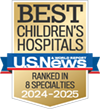Time Out
The concept is simple. Every weekday at 9:05 a.m., leaders from each Le Bonheur Children’s Hospital department gather in a conference room to discuss current issues related to patient safety.
The issues vary each day. The pharmacy has issued a drug shortage for PCA vials. The C-arm X-ray machine is inoperable. Isolation gowns are on backorder.
The daily 15-minute huddle, called a Daily Safety Brief, has improved interdepartmental communication and reduced the time it takes to resolve safety-related issues since it was implemented at April 2015.

The idea is quickly becoming a best practice for children’s hospitals nationwide.
“It’s about bringing the right people together for a focused, deliberate report about safety events and risks,” said Donna Vickery, director of Quality and Performance Improvement at Le Bonheur Children’s.
A Look Back, A Look Ahead
For each brief, one leader from every department comes prepared to report on any significant safety or quality issues that have occurred in the last 24 hours – and any issues expected to occur within the next 24 hours. Issues might include critical drug shortages, missing or inoperative equipment or personnel shortages.
At one of the first Daily Safety Briefs at Le Bonheur, a representative from radiology reported that a piece of diagnostic equipment had been inoperative for two months. The equipment was repaired that very day after being brought to the group’s attention, said Vickery.
The group also discusses any “watchers” – patients deemed to be at highest risk and in need of special interdisciplinary communication and planning.
“The discussions give anyone a structured way to escalate care as needed,” said Vickery. “It helps departments better plan their day.”
Reported issues are prioritized and categorized as green, yellow or red. Red issues are most critical to patient safety. Problems are assigned owners with timeframe for resolution.
Eight months after implementing Daily Safety Briefs more than 70 reported safety-related issues have been resolved.
Situational Awareness
The daily briefings are part of a larger focus of becoming a high reliability organization – a safe hospital with zero patient harm events. And part of high reliability means improving staff’s situational awareness, said Bill May, MD, Le Bonheur’s chief medical officer.
A concept initially formalized by the United States Air Force decades ago, situational awareness is now used in numerous other high-risk industries. In health care, the idea is that situational awareness – or knowing what’s going on within your environment – helps clinicians make better decisions and deliver safe patient care.
“It is important that we are all aware of the status of our facility and its capabilities to deliver efficient and safe care to our patients,” said May. “The briefings align with our mission and purpose to take care of kids and not cause them harm.”
May continues to receive positive feedback from staff about the Daily Safety Briefs. Clinicians appreciate that the discussions help break down silos, allowing them to pool ideas and resources to solve problems.

“Our safety team is multidisciplinary. These meetings allow us to know what our current challenges are and allow us to provide the safest care possible to our patients. The collaboration that occurs is outstanding,” said Cynthia Cross, MD, medical director of the Hospitalist program at Le Bonheur.
The 2015 annual survey measuring staff satisfaction at Le Bonheur reported improved responses to questions about feedback and communication, non-punitive response to error and handoffs and transitions.
“We’ve created more transparency,” said Vickery.
Help us provide the best care for kids.
Le Bonheur Children's Hospital depends on the generosity of friends like you to help us serve 250,000 children each year, regardless of their family’s ability to pay. Every gift helps us improve the lives of children.
Donate Now










